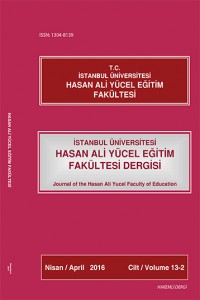Öz
Bu araştırmada Valenzuela, Nieto ve Saiz (2011) tarafından geliştirilen Eleştirel Düşünme Motivasyonu Ölçeği (EDMÖ)’nin Türk dili ve kültürüne uyarlanarak geçerlik ve güvenirliğinin incelenmesi amaçlanmıştır. Uyarlanan ölçek, 312 üniversite öğrencisine uygulanmıştır. Çalışma grubunda yer alan öğrenciler rastgele ikiye bölünmüş ve ilk grup olan 156 kişi ile açımlayıcı faktör analizi yapılmıştır. Ölçekte yer alan 19 maddenin ölçeğin orijinal formunda olduğu gibi beş faktör altında toplandığı görülmüştür. Bu faktörler; beklenti, başarı, içsel değer/ilgi değeri, yararlılık ve bedeldir. Diğer 156 kişiye ait veriler ile de ölçeğin orijinal formunda önerilen modele uyumunu tespit etmek için doğrulayıcı faktör analizi yapılmıştır. Uyum indeks sonuçları, model ve veri arasında kabul edilebilir uyumun sağlandığını göstermiştir. Ayrıca uyarlanan formdan elde edilen verilerin iç tutarlılık katsayısı ve madde toplam korelasyonları hesaplanarak güvenirlik değerleri ortaya konmuştur. Araştırma sonucunda, EDMÖ eğitimciler tarafından öğrencilerin eleştirel düşünmeye yönelik motivasyonlarını ölçmek amacıyla Türkçe’de kullanılabilecek bir ölçek olarak önerilmiştir.
Anahtar Kelimeler
Kaynakça
- Eccles, J. S., & Wigfield, A. (2002). Motivational beliefs, values, and goals. Annual Review of Pyschology, 53, 109-132. DOI: 10.1146/annurev.psych.53.100901.135153
- Ennis, R. H. (1993). Critical thinking assessment. Theory Into Practice, 35(3), 179-186. DOI: 10.1080/00405849309543594
- Facione, P. A. (1990). A statement of expert consensus for purposes of educational assessment and instruction. Newark, DE: American Philosophical Association.
- Garcia, T., Pintrich, P. R., & Paul, R. (1992, August). Critical thinking and its relationship to motivation, learning strategies and classroom experience. Paper presented at the 100th annual meeting of the American Psychological Association Washington, DC.
- Hambleton, R. K., & Patsula, L. (1999). Increasing the validity of adapted tests: Myths to be avoided and guidelines for improving test adaptation practices. Association of Test Publishers, 1(1), 1-13.
- Paul, R. (2005). The state of critical thinking today. New Directions For Community Colleges, 130, 27-38.
- Schunk, D. H. (2002). Learning theories an educational perspective 6th edition. Boston: Pearson.
- Thompson, B. (2002). Exploratory and confirmatory factor analysis: Understanding concepts and Applications. Washington, DC: American Psychological Association.
- Valenzuela, J., Nieto, A. M., & Saiz, C. (2011). Critical thinking motivational scale: a contribution to the study of relationship between critical thinking and motivation. Journal of Research in Educational Psychology, 9(2), 823-848.
Öz
The aim of this study was to adapt the Critical
Thinking Motivational Scale, developed by Valenzuela, Nieto, and Saiz, into
Turkish and evaluate its validity and reliability. The original scale was first
translated into Turkish and then administered to 312
university students. It was found that 19 items were placed under five factors
as occurred in the original scale. These factors are expectancy, attainment, intrinsic/interest
value, utility, and cost. Then, a confirmatory factor analysis was performed to
determine if it fits to the model in the original scale. Compliance index results
showed that the fit between model and data provided acceptable. Besides,
reliability of the measurement on the adapted form was evaluated by calculating
internal consistency and item-scale correlations. It was concluded that the
Turkish form can be used to assess students’ critical thinking motivation.
Anahtar Kelimeler
Kaynakça
- Eccles, J. S., & Wigfield, A. (2002). Motivational beliefs, values, and goals. Annual Review of Pyschology, 53, 109-132. DOI: 10.1146/annurev.psych.53.100901.135153
- Ennis, R. H. (1993). Critical thinking assessment. Theory Into Practice, 35(3), 179-186. DOI: 10.1080/00405849309543594
- Facione, P. A. (1990). A statement of expert consensus for purposes of educational assessment and instruction. Newark, DE: American Philosophical Association.
- Garcia, T., Pintrich, P. R., & Paul, R. (1992, August). Critical thinking and its relationship to motivation, learning strategies and classroom experience. Paper presented at the 100th annual meeting of the American Psychological Association Washington, DC.
- Hambleton, R. K., & Patsula, L. (1999). Increasing the validity of adapted tests: Myths to be avoided and guidelines for improving test adaptation practices. Association of Test Publishers, 1(1), 1-13.
- Paul, R. (2005). The state of critical thinking today. New Directions For Community Colleges, 130, 27-38.
- Schunk, D. H. (2002). Learning theories an educational perspective 6th edition. Boston: Pearson.
- Thompson, B. (2002). Exploratory and confirmatory factor analysis: Understanding concepts and Applications. Washington, DC: American Psychological Association.
- Valenzuela, J., Nieto, A. M., & Saiz, C. (2011). Critical thinking motivational scale: a contribution to the study of relationship between critical thinking and motivation. Journal of Research in Educational Psychology, 9(2), 823-848.
Ayrıntılar
| Bölüm | Tez Makaleleri |
|---|---|
| Yazarlar | |
| Yayımlanma Tarihi | 28 Temmuz 2016 |
| Yayımlandığı Sayı | Yıl 2016 Cilt: 13 Sayı: 2 |


